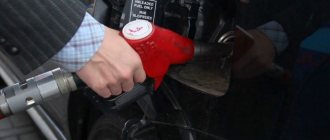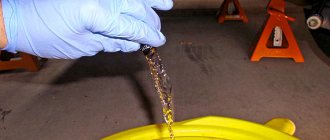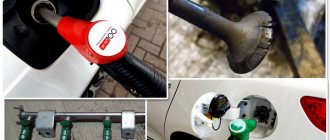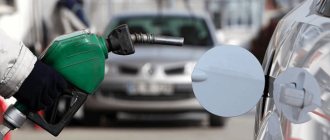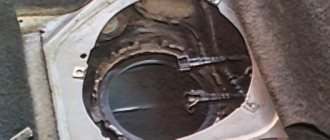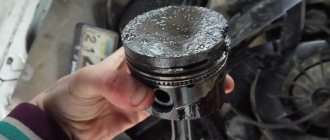In order for the machine to serve for a long time and properly, it is necessary to monitor it, and this requires certain knowledge and skills. Today, thanks to the Internet, you can learn how to replace certain car parts in a short time. You can also learn how to drain gasoline yourself. There is nothing difficult about this if you know how to act.
How to drain gasoline from a Priora
Sometimes, urgently, you need to drain gasoline from the car’s gas tank. The reasons for this decision may vary. For example, low-quality fuel was filled, a small amount of it is needed for operation, or some work needs to be done on the side of the fuel tank. In this article we will tell you how to drain gasoline from a Priora
Whatever the reason, you won’t be able to quickly drain gasoline the old fashioned way using a hose. The thing is that the tank neck is made in a special way and, due to its curved shape, does not allow gasoline to be pumped out using foreign objects.
Of course, you can drain gasoline from the Priora’s tank by inserting a very thin hose into it and twisting it, but the process can take a long time. Therefore, it is worth talking about some more effective ways.
Three ways to drain gasoline from a Priora There are several available methods from which you can choose at your discretion.
The options are as follows:
1. Using a hose. 2. After removing the fuel pump. 3. Using the fuel pressure control fitting.
Method No1
The method using a hose involves immersing one end of it into the gas tank to the required depth. The second end is placed in a container to collect gasoline. Everything seems to be simple. But as mentioned earlier, there is a catch in the form of a special neck. It is possible to bypass it; for this you need a very thin hose with a diameter of no more than 6 millimeters. Moreover, this method will take a lot of time. To speed up the process, it is recommended to place the machine higher and the drain container lower. A pit or a lift is perfect. The draining time depends on the amount of gasoline in the tank and the hose itself.
Method No2
The most time-consuming and labor-intensive method. It consists in
to gain access directly to the gas tank itself, bypassing the neck. To do this you need:
- Inside the car, recline or remove the rear seat.
- Find and unscrew the protective cap of the fuel pump.
- Remove the hoses from the pump connections.
- Remove the protective ring.
- Unscrew the fuel pump mount.
- When removing the device, slowly rotate it or tilt it from side to side (so as not to damage the float).
After which, there will be free access to the gasoline in the tank. You can pump it out using the same hose, only now with a larger diameter.
Method No3
Now to the question of whether it is possible to drain gasoline from a Priora as simply as possible. The answer is of course!
To do this, you will need a metal cap for unscrewing the spool, a hose, and a container for gasoline.
The procedure is:
- Open the car hood.
- Find the fuel pressure control fitting. Unscrew the plastic protective cap by hand.
- Take the metal cap with a special groove in your hand and begin to unscrew the valve spool. Be extremely careful not to drop the spool. Use the spool to unscrew the valve on the ramp
After unscrewing, tightly pull one end of the hose you prepared onto the fitting. On the other side of the hose, attach or place a container to collect fuel. Connect the hose to the ramp
- Move into the car interior. Turn the ignition key (you do not need to start the car) so that the fuel pump begins to pump fuel.
- The container will begin to fill with gasoline. The filling process takes a few seconds, during which about 200 grams of gasoline are drained. To fill the container with a large amount, turn on the ignition several times.
- After collecting the required amount of fuel, reassemble everything in reverse order.
You should know that the draining method described above is not suitable for all engines with which the Lada Priora is equipped. In cases where there is another mechanism in the fitting (not a spool), the high-pressure supply hose (to the ramp) should be removed, as a result the fuel will drain out even faster.
Didn't find the information you are looking for? on our forum.
Installing contactless ignition on a VAZ 2121
How to check the vacuum on a VAZ 2107, replacement, procedure, diagram
VAZ 2115 check engine light on reasons
VAZ 21124 for cold troit. Main reasons
VAZ 2110, when you press the gas, the car choke on the injector
The dimensions on the VAZ 2110 are missing, the reason for how to repair it
Running in a VAZ engine after a major overhaul
How to change pads on a VAZ 2112
Draining fuel from the injector
Modern cars do not have the ability to pump gasoline through the filler neck of the fuel tank. In this case, fuel is drained from the injector.
In modern cars, fuel cannot be pumped out through the filler neck.
The action plan is as follows:
- you need to open the neck of the fuel tank;
- you need to find a special rubber tube under the hood that supplies fuel to the ramp;
- you need to remove the clamp and also disconnect the fuel hose;
- after this you need to turn the ignition key;
- Next, you should remove the relay, which is responsible for the operating mode of the pump;
- you need to bridge the contacts and turn on the ignition;
It is important to monitor the condition of the pump and periodically turn off the ignition. This must be done when the gasoline begins to foam.
If you miss the moment, the pump will fail.
Method 1. How to drain gasoline using a hose
The classic method that our grandfathers used. To drain the fuel you need to prepare two things:
- A hose (tube), the length of which depends on the design of the tank.
- Clean container for gasoline.
In the simplest case, the fuel pumping operation goes like this:
- Lower the hose (tube) into the tank so that it is immersed in gasoline.
- Cover the free end with your lips and draw in a strong breath.
- Direct the hose into the prepared container.
All that remains is to wait for all the fuel to flow out.
To drain only part of the fuel, it is enough to lift the hose above the neck so that gasoline stops flowing out.
Gasoline and octane boosters are harmful to health. Therefore, it is necessary to avoid their entry of fuel and its vapors into the body.
To prevent gasoline from getting onto the mucous membranes or into the stomach, special hoses are used to pump fuel. They are equipped with a bulb that must be squeezed before immersing the tube in the fuel and then released. If the design is not equipped with a check valve, vacuum in the line is created in a simple way:
- squeeze the pear;
- lower the hose into the gas tank;
- plug the hose outlet with your finger;
- release the rubber bulb;
- remove your finger.
The bulb can be replaced with an improvised piston. To do this, you will need a rope that runs freely inside the tube. It is better that it is made of soft natural material and not nylon. At the end of the rope you need to tie several knots, and then:
- Thread the rope and pull lightly so that the piston from the knots enters the hose.
- Insert the hose into the gas tank.
- Smoothly pull out the rope.
- Lower the hose (tube) into the prepared fuel container.
- remove your finger.
The moving “piston” creates a vacuum that causes gasoline to flow from the tank.
However, all tricks with a hose are only relevant for old cars. The gas tank of modern cars (Grants, Largus, Toyota, Niva, Priora, Patriot, Ford, Chevrolet) is located far from the filler neck. In this case, you need to use other methods.
Solving a problem using a handset
A well-known and proven method is removal using a tube. This is an old “grandfather’s” method that is still relevant among car enthusiasts today. In this case, draining occurs through a tube into a volumetric container.
Today, special bulb pumps are widely used to drain gasoline. With their help, you can quickly and safely drain the required amount of fuel. In appearance it resembles a device for measuring blood pressure. If you buy it in time, you can easily drain gasoline from any car, be it a Lada Priora or a Skoda Octavia.
What Oil to Pour into Kalina for the Winter ~ AUTOINTERLINE.RU
This is the first thing a new car owner has to deal with. This is to find out what technical water is poured into the machine and how soon it should be changed. The engine is considered the main unit, so in most cases they start with engine oil.
Let us remind you that AvtoVAZ installs it on its models, so the advice on what oil to pour into the engine will be similar for all modern Lada cars (Granta, Priora, Kalina, Largus, Niva, Vesta or XRAY). We select Niva 4x4 engine oil in.
What motor oils are recommended by AvtoVAZ? If you open the Administration for the Operation of a Vehicle and Its Modifications, not the latest edition, you can find Table 2 “Motor Oils”. Comparing them for different Lada cars, you can realize that AvtoVAZ recommends similar motor oils for Lada Granta/Kalina/Priora engines.
THIS IS INTERESTING: Installing xenon Mazda 6
For Lada Vesta, AvtoVAZ recommends using Rosneft brand motor oil, API class SL, SM or SN. What brand of oil does the Lada come from the factory? From time to time, information about the filled engine oil is indicated on a tag under the hood. In most cases, AvtoVAZ fills with Lukoil semi-synthetic/mineral motor oil. During maintenance, the manufacturer fills in ROSNEFT 5W-30 motor oil (semi-synthetic).
You can top up with ROSNEFT Premium or ROSNEFT Maximum 5W-40 or 10W-40.
Find the viscosity of motor oil How to find the composition of motor oil? To answer this question, we conducted surveys among the owners of Lada Grant, Lada Kalina and Lada Priora, asking them to answer the question “What oil composition do you use in your own car?” and in the end we received approximately similar results:
What kind of oil should I use? why I like Lukoil and not like Shell
Which company should I use the oil for?
The survey below will help you decide on the choice of engine oil. Participate in our survey and discussions. Let us remind you that the website also contains advice on viscosity and composition. By the way, the HR16 engine is also installed on the Lada Vesta; read tips on choosing lubricants for it. For Lada Largus with Renault K4M or K7M engine.
The service life and service life of both the engine and the gearbox depend on the lubricants used in the car. Nowadays, practically no one has problems with fuel and lubricants; the main thing is not to run into a fake.
After all, even the most ordinary and cheap oils, such as Lukoil semi-synthetic, are completely justified and engines run on it for more than 300,000 km without long repairs, tested from personal experience.
And below there will be another table that will help you decide on the choice for your weather conditions We have already figured out the oils for Lada Kalina engines, now we will look at the transmission ones below, for gearboxes. I would also like to note that the manufacturer strongly advises against using additional additives for both engine and and for transmission oils, since modern fuels and lubricants already have all the necessary components for the flawless operation of all components and assemblies. From personal experience I can say that I filled my Kalina with ZIC A semi-synthetic, and the TNK Magnum gearbox is also semi-synthetic.
After removing the valve cover, I turned my attention to the condition of the camshaft, everything was impeccably clean, there was no waste at all. From shift to shift the level on the dipstick was the same
The motor runs quietly, there are no vibrations, in general I am satisfied.
As for the gearbox, after the TNK there was only a little less extraneous sound, well, that may be self-hypnosis, but at low temperatures the gears became more noticeable and easier to engage. Here, for example, is the appearance of the engine after 40,000 km of operation with ZIC A oil. In this photo, the oil is already ready for replacement, but it is clear that there are no deposits or deposits, one can say that everything is impeccably clean.
The only thing that pushed me to buy ZIC was the iron canister, which leaves little hope that what’s inside is original and not a fake.
When and what liquid to pour?
As you can see from the table, AvtoVAZ recommends filling in several types of oils and liquids. So let's figure out what liquid to fill and when.
Engine lubrication system
It is recommended to fill the Lada Priora engine with several types of automotive oils according to the SAE (American Association of Engineers) classification. In order to determine what kind of oil to pour into the engine, it is necessary to rely on the air temperature at which the car will be operated. The table below shows the temperature and oil used at a certain temperature.
Oil table depending on air temperature
| Outdoor temperature | SAE oil classification |
| -25 to +35℃ | 5W-40 |
| -25 to +20℃ | 5W-30 |
| -20 to +35℃ | 10W-40 |
| -20 to +30℃ | 10W-30 |
| -15 to +45℃ | 15W-40 |
Based on this table, it is necessary to select the required oil in the Lada Priora according to the degree of viscosity. The manufacturer recommends changing the engine oil no later than 15 thousand km, but it is better to change it at 10 thousand km.
Gear box
The choice of oil for the Lada Priora gearbox is based in the same way as the choice of engine oil on the ambient temperature in which the car will be operated.
Below is a table of transmission oil depending on air temperature.
Table of dependence of transmission oil on air temperature
| Outdoor temperature | SAE oil classification |
| From -26 to +45℃ | 80W-85 |
| -40 to +40℃ | 75W-90 |
AvtoVAZ recommends changing the oil in the gearbox no later than 75 thousand km, but in practice it is better to change the oil after 50 thousand km.
Engine cooling system
The manufacturer recommends adding antifreeze or antifreeze to the engine cooling system. The volume of Priora coolant is 7.9 liters. It should be noted that antifreeze is filled at the Priora plant. Under no circumstances should you ever use water as a coolant, since when the air temperature drops, the cylinder head may defrost with dire consequences and costly repairs.
Fuel tank
The Priora's fuel tank capacity is 43 liters, which is quite enough for an engine capacity of 1.6 liters. AvtoVAZ recommends using only high-octane gasoline, namely AI-95. It should be noted that on a full tank the Priora can travel from 400 to 600 km, depending on driving style.
Hydraulic Brake System
Priora is equipped with a system with hydraulic brakes and ABS. The volume of Priora brake fluid is 1 liter. DOT-4 brake fluid. It is recommended to replace brake fluid every 2-3 years, as brake fluid tends to age.
Windshield washer reservoir
The Lada Priora washer reservoir contains 2.2 liters of special liquid for cleaning the windshield from dirt. It is necessary to use a special liquid that does not freeze down to -40 degrees. During summer time, filling with ordinary water is allowed.
We hope our article was useful to you.
We use pumps
Technologies do not stand still. To drain gasoline from a tank, you can use ready-made solutions - these are manual and electric pumps for pumping liquids.
Electrical devices will require 12V/24V power. They are either submersible or non-submersible. For passenger cars, the second option is suitable.
But you need to understand that there are pumps that can only pump diesel fuel, water, oils, but not gasoline. Therefore, before purchasing such a device, carefully read the instructions for it.
But for non-everyday use, it is more advisable to have hand pumps; they are much cheaper and no less effective.
Is it possible to fill 92 gasoline instead of 95 in a Lada Granta, which is better?
There is an opinion among owners of domestic cars that their vehicles can be fueled with almost any fuel that is on the market. This statement dates back to those times when, apart from the “VAZ classics,” nothing more modern could be found on the roads.
Only 95 gasoline?
AvtoVAZ recommends 95 type gasoline
Modern VAZ cars are equipped with a large number of electronic systems that require good treatment and quality care. This also applies to the brand of fuel that is filled into the tank.
But is it worth adhering to the recommendation, or can you deviate from it a little? Now we will find out about this.
Is it possible to refuel with A-92 gasoline?
There is such a thing as octane number, which is determined in digital terms by the name of the fuel. If the vehicle in question is recommended to use 95 gasoline, there are reasons for this.
The fact is that the engine, which is designed for A-95 gasoline, can start working with any type of fuel. He won't do octane tests. Instead, to put it simply, it will treat any gasoline as if it were A-95, compressing it accordingly.
And, given that A-92 fuel has an octane rating of three units less, its possible compression ratio may be lower than in the case of the recommended fuel. This may not be noticeable if the engine has already traveled more than one or two hundred thousand kilometers, since the compression performance of the combustion chamber decreases somewhat.
Try to refuel at large chain gas stations.
If you fill in with high-quality 92-grade gasoline, then no errors will appear on the instrument panel after starting the engine; this is precisely the main argument of those who like to refuel with gasoline with a lower octane number.
So, if you do not want to hear the sounds of detonation, and also eliminate premature wear of car parts in the near future, then you should listen to the recommendations of the car exactly what is written in the operating instructions.
Video of a test measurement of the real octane number of 92 gasoline
The video below shows the process of measuring the octane number of gasoline that was purchased at regular gas stations in Novosibirsk. Only one sampler showed the presence of truly 92-grade gasoline.
Simply put, the result of using any fuel with a lower grade will be the appearance of unintended detonations and difficulty starting a cold engine.
They are very small local explosions that damage the condition of the cylinder and, to some extent, the piston. Moreover, all this can lead to increased wear and, most importantly, increased fuel consumption.
So any attempts to save on cheaper gasoline will be doomed to failure.
What then to do with “older” gasoline?
Let's fill up with 98?
If you consider the above information, you might think that it would then be advisable to fill your car with gasoline with a higher octane number. For example, this could be the A-98, which is the standard for many modern foreign-made cars.
But here again we will have to disappoint you, since the mechanism requires a clear and correct attitude towards itself. Therefore, if the compression ratio is designed for A-95, then A-98 gasoline will be compressed to exactly the same level. And the potential of this fuel can only be revealed when its compression force is higher, which the Lada Grant engine is not designed for.
What else is used to drain gasoline?
You can also drain it using the fuel channel. This is done like this:
- First, the nipple, which is located at the end of the ramp, is unscrewed.
- Then a standard hose is put on the ramp, and the other end is immersed in a container.
- Next, you need to make sure that the fuel pump pumps gasoline.
It should be noted that it is necessary to resort to draining gasoline only in special cases when there is no other solution to the problem. If the work is performed poorly, the warranty period of the machine will expire. The fact is that such procedures violate warranty requirements. It is best to refuel at special gas stations and, if you need to drain it, contact a specialist. After all, only they can perform the work in such a way as not to violate warranty requirements. It is also important to monitor the amount of fuel while driving. With this approach, there will be no problems with the gas tank.
Automotive fuel
Gasoline is a mixture of hydrocarbons that has the following properties:
- highly flammable;
- mostly colorless;
- density 700-780 kg/m2;
- highly volatile and flares up at 20-40° C;
- boils at 30-200° C;
- freezes at -60° C.
To improve the quality, 0.07-0.2% additives are added to the fuel:
- Antiknock agents (monomethylaniline 15%).
- Antioxidants.
- Anti-corrosion agents for metals.
These additives are poisonous, environmentally hazardous and produce high temperatures during combustion, which can damage the car engine.
It is best to use methyl carbinol and dimethyl ketone when necessary, as they are less toxic. If you add one hundred milliliters of ethanol to one liter of AI-92 fuel, you will get AI-95, since the octane number increases.
Gasoline is obtained from oil; it has two main technical characteristics, indicated by letters and numbers:
- A – motor.
- Brand AI – research.
- The numbers 92, 95 are the percentage of isooctane with heptane.
- The octane number characterizes the resistance of gasoline to detonation. The higher the percentage, the lower the probability of failure of the cylinder-piston group of parts.
- Detonation is the arbitrary spontaneous ignition of gasoline under pressure with consequences in the form of an explosion.
AI-92:
- used to operate carburetor internal combustion engines; detonation resistant;
- ensures stable engine operation;
- is widely popular in Russia and the CIS countries;
- summer is used in the southern regions of the Russian Federation throughout the year, and in the northern regions - from 01.04 to 01.10;
- winter - in the north of the country from 01.10 to 01.04;
- 4th class according to EURO-4 standard;
- works from +60 to -35-55° C;
- stores well and for a long time;
- burns quickly and evaporates during processing.
Chemical composition:
- contains sulfur – no more than 0.05%;
- there is manganese - in 1 dm³ - 18 mg;
- resin composition per 100 cm³ – up to 5 mg;
- etiolation possible (0.15 g/l Pb);
- without etiolation (0.013 g/l);
- can boil at 33-205° C;
- There is no more than 5% benzene;
- p at 15 °C kg/ – 725-780;
- clear liquid.
Foreign cars
Lada Largus, Renault Logan, Sandero, Duster
It is no coincidence that we classified Lada Largus as a foreign car, because this car is made on the Renault platform, which means their fuel systems are similar, especially with Renault Logan.
The fuel tanks of these cars are located low, so you won’t be able to drain gasoline using a hose, but you can go the other way.
Remove the back seat so you can get to the fuel pump. Connect the pumping hose to the outlet fitting. Next, close the pump relay. The latter will begin to pump out gasoline.
For example, let's take Renault Duster. First, relieve the pressure in the system. To do this, disconnect the electrical connector from the pump and start the car for a few seconds.
- Prepare a PVC hose with an internal diameter of 10 mm. Since the fuel supply flange has a diameter of 11 mm, this will eliminate air leaks.
- Using a screwdriver, connect one end of the pipe to the fitting, and lower the other into the canister.
- Find the pump relay, marked “K 4” in the diagram and close contacts B5 and B3 on it.
- The pump will begin to drain gasoline, but the ignition key will not turn.
IMPORTANT: Do not allow air to enter the pump.
From a Ford tank
Let's look at the example of Ford Focus 2. It will not be possible to drain gasoline through the filler neck; the valve, mesh, and bends in the fuel line will not allow this to be done.
You can remove the fuel tank, but this is labor-intensive work, so the game is not worth the candle.
The option directly through the fuel pump is attractive, but provided that you have already changed this element of the fuel system before and cut a hole in the bottom under the rear seats, an explanation is here https://autotopik.ru/ford/1353-zamena-benzonasosa-fokus-2. html. If not, then cutting metal just to drain gasoline is impractical.
The simplest option is to disconnect the tube from the fuel rail, it is secured with a latch, connect a hose with a diameter of 8 mm and drain the fuel by turning on the ignition.
But if the tank is full, which is 55 liters, and 4 liters are drained per minute, then the whole process will take a lot of time and the battery can be drained. Therefore, we find the fuel pump relay and close two contacts on them (two lower slots). Don't forget to add a larger container.
Turn on the ignition and drain the gasoline. Be careful, it can leak even without the ignition on, immediately when the relay contacts close.
Replacing the sediment filter
How to properly drain gasoline from the gas tank of a VAZ and foreign car
All you need to work here is:
- Inspection hole.
- Key for 10.
- Bucket or basin.
- New filter.
You can only reach this part while under the car. Therefore, in any case, you will need to drive the Priora into a metalworking inspection pit. Or use a lift. So, the car is in the pit, we can begin. First release the pressure in the fuel system. To do this, you need to unscrew the nipple cap on the nozzle frame. It is located directly above the generator, in the engine compartment. Press the nipple of the nipple and release the pressure. After that, go down under the car. Place a container to prevent fuel from spilling on the floor when removing the filter. Pressing the clamps, remove the pipes from the sump. It’s good to notice the position and unscrew the fastening bolt of the clamp. Install a new sediment filter, tighten the fasteners and secure the fuel lines. Well, that's the whole replacement.
How to drain fuel from a gas tank with your own hands: reasons for draining, methods
As a rule, it is necessary to drain for the following reasons:
- if the car is filled with low quality gasoline. Some car enthusiasts purchase cheap fuel, not realizing how many problems there will be later, and that they will still have to spend money on new ones;
- in order to refuel the generator and thus recharge the battery;
- due to excess fuel.
Regardless of the reasons, this procedure can be performed in several ways:
- Through the filler neck.
- Through the fuel pump.
- Through the cap at the bottom of the gas tank.
Removal through the neck is easiest.
It is enough to use a hose with a diameter of 9-15 mm and a length of 2 m. Then proceed as follows:
- insert it through the neck into the tank, turning it counterclockwise;
- Install the canister as low as possible.
You can also remove the fuel pump and pump out the fuel without any problems. Dismantling is done as follows:
- recline the rear seat cushion;
- lift the mat and unscrew the screws with a Phillips screwdriver;
- disconnect the deck with electrical wires;
- remove fuel hoses;
- the pressure glass is turned away;
- then the fuel pump is removed by tilting it to the side. This is done in order not to damage the lever, because it can also move, and then inaccurate indicators of the amount of fuel in the tank will be displayed.
Removing the fuel tank Lada Granta
Car gas tank device and principle of operation
Tools:
- Open-end wrench 10 mm
- Medium flat screwdriver
- Small hammer
- Medium Phillips screwdriver
- Ratchet wrench
- Extension
- 8 mm head
- 10 mm high head
- 13 mm head
- Support
Parts and consumables:
- Hose
- Canister
Notes:
Remove the fuel tank to wash or replace it. Carry out the work on an inspection ditch or overpass. Perform operations when the tank is empty or when there is no more than 5 liters of fuel left in it. Fuel can be removed from the tank by removing the fuel module and pumping gasoline into a canister with a hose through a hole in the tank. If you do not dismantle the fuel module, then disconnect the wiring harness block from the connector of its cover, as described here.
1. Using a 10 mm high socket, unscrew the four nuts securing the heat shield of the tank and remove the screen.
2. Remove the fuel tank heat shield.
3. Unscrew the three nuts 1 securing the protection 2 of the fuel line hoses and remove the protection of the fuel hoses.
4. Having released the spring clamps, disconnect the tips of the fuel hoses installed on the gas tank from the fuel line fittings.
Fuel pipes Lada Granta:
1 – adsorber tube;
2 – fuel filter and fuel pipe;
3 – fuel hose;
4 – middle steam pipe.
5. Similarly, disconnect the gravity valve hose from the fuel hose of the gas tank.
6. Using a Phillips screwdriver, loosen the clamp securing the connecting hose to the gas tank filler neck and disconnect the hose from the gas tank nozzle.
7. Disconnect the air outlet hose of the filler neck from the fitting at the rear of the gas tank by pressing the spring clamp on its tip.
8. Place a support under the fuel tank (gas tank).
9. Using a 13 mm socket, unscrew the two bolts 1 of the fuel tank fastening clamps 2 (gas tank 3) and move the gas tank fastening clamps forward.
Fuel tank mounting:
1 – bolts for fixing the gas tank clamps;
2 – clamps for fixing the fuel tank;
3 – fuel tank.
10. Remove the fuel tank assembly with the adsorber, fuel module, fuel filter and tubes connecting them.
11. Install the fuel tank in reverse order.
The article is missing:
- Photo of the instrument
- Photos of parts and consumables
- High-quality photos of repairs
Reasons for draining gasoline
To force a driver to drain fuel from a car, there must be compelling reasons. Let's consider the main ones:
- The need to repair the vehicle. This could be due to a traffic accident or planned restoration of body parts. For safety reasons, the fuel tank is removed, and then the fuel is drained.
- Cleaning the fuel system and gas tank. To clean the system, automotive chemicals are often used, and therefore it is worth removing fuel from the entire system.
- Replacing or repairing a gas tank is one of the reasons why you may need to drain the fuel.
Method 2. Drain gasoline through the fuel line and the plug at the bottom of the gas tank
If the fuel pump is located not in the tank itself, but near the engine, you can try to drain the fuel through the fuel line. Procedure:
- Unscrew the clamp and disconnect the hose going from the tank to the fuel pump.
- Place the hose into the fuel container.
Fuel will leak from the gas tank. The main thing is that the end of the fuel line, as well as the fuel container, is located below the gasoline level.
Some cars have gas tanks with drain plugs. If you are the owner of just such a car model, you need to use an overpass or inspection hole to drain the fuel. This is done simply:
- Place a container under the drain plug in the gas tank.
- Unscrew the plug.
- Drain the fuel (all or part of it).
- Tighten the plug.
However, plugs at the bottom of the tank are not very common. In this case, the fuel pump will help drain the gasoline. The method is suitable for old modern cars.
How to drain gasoline from a Lada Granta tank: photos and videos
In our country, finding high-quality gasoline is not much easier than finding smooth roads. So you have to think for yourself about how to make driving a car as safe as possible, both for yourself and for the car’s mechanisms.
Why might you need to drain the gasoline?
It often happens that very low quality fuel gets into the tank, which is dangerous for the car and can even damage some of its components. You can notice such a problem by the fact that immediately after refueling the car begins to move at a jerky pace, or by the fact that the engine stalls and refuses to start again. In this situation, it is necessary to drain the low-quality gasoline and replace it with a new one of higher quality.
But, if in cars of previous years of production this was quite simple to do, using a regular hose, then for the Lada Grant the solution to the situation has become much more difficult.
Features of draining gasoline from the Lada Granta tank
The fact is that you won’t be able to drain the fuel using the “old-fashioned” method through the neck.
The reason for this is the low location of the fuel tank, as well as the specific design of the neck. The same applies to other modern VAZ models, as well as foreign cars produced since the 90s.
We tried this method, it is drained only with a thin hose and no more than “half a bucket”, depending on the current volume of filling the gas tank.
Method 1: Using the fuel line under the hood
In this situation, the simplest method is to use a fuel channel.
- To begin with, you will need to unscrew the nipple, which is located at the end of the injector ramp. The nipple has been unscrewed, marked with an arrow
- After this, a regular hose is put on this ramp, the other end of which is immersed in any container that is sufficient to hold gasoline. Despite the fact that almost any hose will do, experts recommend using special types of hoses that are used to refill home air conditioners. This will allow you to screw the hose onto the fuel rail without unscrewing the nipple at all. Put the hose on, the other end into the container
- After this, you will need to force the gas pump to pump gasoline. The most obvious solution is to turn on the ignition, which will make the pump work.
- But there is one peculiarity: the pump will not be able to function in this mode for more than a few seconds. In order for the duration of its operation to be increased, up to constant operation, you will need to turn on the ignition, and then insert the corresponding jumper into the gasoline pump relay (number K12 in the fuse box). An alternative to this may be the need to bridge contacts number 11 and 16, which are located in the diagnostic connector. This will make it possible for the pump to operate even without ignition.
Technical characteristics of Lada Granta Lada Granta
How to drain gasoline from the tank of a modern car
The new Lada Granta is built on the basis of the Kalina model; at first the car will be produced in a sedan body, and from 2013 a hatchback will appear.
The car is offered in three trim levels: “Standard”, “Norma” and “Lux”. The “Standard” version received a 1.6-liter engine from Kalina, the other two are offered with a new 1.6-liter 8-valve power unit with a capacity of 80 and 90 hp, respectively. Transmission: 5-speed manual, front-wheel drive.
All engine options run on AI-95 gasoline, their average consumption is from 8.7 to 9.3 liters per hundred in the city, from 5.8 to 6.1 liters outside the city and from 7.2 to 7.3 liters - in a mixed cycle.
The maximum speed of the most powerful modification of the Lada Grant, according to the manufacturer, is 168.5 km/h. Acceleration from zero to hundreds takes 12.0 seconds.
For more detailed technical characteristics of the Lada Grant, see the table below. The cost of the Lada Grant can be found in the corresponding section of the website.
| Automobile | Lada Granta (VAZ-2190) | ||
| Modification | "Standard" | "Norm" | “Lux” |
| Body type | Four-door sedan | ||
| Number of places | 5 | ||
| Length, mm | 4260 | ||
| Width, mm | 1700 | ||
| Height, mm | 1500 | ||
| Base, mm | 2470 | ||
| Front track, mm | 1430 | ||
| Rear track, mm | 1410 | ||
| Pedeniy overhang, mm | 810 | ||
| Rear overhang, mm | 980 | ||
| Min. ground clearance, mm | 160 | ||
| Trunk volume, l | 500 | ||
| Curb weight, kg | 1040 | 1080 | 1100 |
| Distribution of curb weight along front/rear axles, % | 59/41 | 59/41 | 59/41 |
| Payload, kg | 475 | ||
| Total weight, kg | 1515 | 1555 | 1575 |
| Distribution of total weight along the front/rear axles, % | 50/50 | 50/50 | 50/50 |
| Trailer weight with/without brakes, kg | 900/450 | ||
| Aerodynamic drag coefficient | 0,367 | 0,353 | |
| Engine | Gasoline, with distributed injection | ||
| Engine designation | VAZ-11183 | VAZ-21116 | |
| Location | front, transverse | ||
| Number and arrangement of cylinders | 4, in a row | ||
| Working volume, cm3 | 1597 | ||
| Cylinder diameter/piston stroke, mm | 82,0/75,6 | ||
| Compression ratio | 9,8:1 | 10,5:1 | |
| Number of valves | 8 | ||
| Maximum power, hp/kW/rpm | 80/59/5600 | 90/66/5600 | |
| Maximum torque, Nm/rpm | 132/3500 | 143/3500 | |
| Transmission | manual, 5-speed | ||
| Drive unit | front | ||
| Front suspension | independent, spring, McPherson | ||
| Rear suspension | semi-independent, spring | ||
| Front brakes | disc, ventilated | ||
| Rear brakes | drums | ||
| Tires | 175/70 R13 | 175/65 R14 | |
| Maximum speed, km/h | 164,5 | 167,0 | 168,5 |
| Acceleration time from 0 to 100 km/h, s | 12,5 | 11,8 | 12,0 |
| Fuel consumption, l/100km | |||
| - in city mode | 9,3 | 8,5 | 8,7 |
| - in suburban mode | 6,1 | 5,7 | 5,8 |
| - in mixed mode | 7,3 | 7,2 | 7,3 |
| CO2 emissions, g/km (combined cycle) | 177 | 164 | 164 |
| Fuel tank capacity, l | 50 | ||
| Fuel | Gasoline AI-95 |
Download Lada Granta instruction manual
Domestic cars
VAZ 2110/2112/2114/ 16 valves injector
The methods listed below are also suitable for those cars where there is a protective mesh in the fuel neck.
You need to drain gasoline on a cold engine.
- connector for connecting to the fuel pump (sold separately) and a wire to it up to 3 meters long.
- a hose up to 3 meters long and with a diameter suitable for the fuel pump fitting.
- clamp;
- two crocodiles for connecting to the battery;
- metal canister;
- rags.
Fold down the two rear seats and unscrew the fuel pump access flap. Disconnect the wire connector. Relieve pressure in the system. To do this, remove the engine protective cover. Find the special fitting (it is shown in the photo below) and release the pressure by pressing the button. To prevent fuel from spilling, place a small container with a volume of up to 0.5 liters. Find the gasoline supply hose on the pump; as a rule, it is single. Double return hose. Follow the arrow on the pump cover. By pressing the bracket, remove the fuel supply hose. Connect the prepared hose to the fitting and secure it with a clamp. Place its other end into the prepared container. Connect a pre-prepared connector to the pump by first extending its wire to 3 meters. Remember where the positive and negative wires are located and use alligator clips to connect them to the battery. Plus to plus, minus to minus. Gasoline will begin to flow into the container. Reverse the steps to return everything to its original position.
Please note, do not rush to remove the hose from the canister. First, disconnect it from the fitting and drain the remaining gasoline.
Similar to the first one, only we disconnect the hose in front near the engine:
- To the right of the engine near the exhaust manifold, find the fuel supply hose. It releases easily thanks to the spring latches. The disconnect location is shown in the diagram below.
- Connect to it a pre-prepared hose at least 3 meters long. Place the other end into a metal container.
- Turn on the ignition. The pump will start working and pump out fuel. It is not recommended to start the car as the pump may fail.
About 100 - 150 ml of gasoline will drain at a time. Next, turn off the ignition and turn it on again.
Suitable for injection vehicles VAZ 2110, 2112, 2114, Lada Granta. We also take a hose and container.
- Remove the fuel pressure valve cap and use a regular cap to unscrew the nipple.
- Insert the hose. We lower its second end into the canister.
- Turn on the ignition. While the pump is pumping, gasoline will drain.
- We repeat the procedure until we add the required amount of fuel.
Methods 2 and 3 are not suitable for situations where you need to completely drain the gasoline. Frequently turning the ignition on and off will quickly drain the battery, and if you start the car, there is a high probability that the pump will idle and burn out.
On the Lada Granta we also find a fitting for measuring pressure, it is located in the same place as on the VAZ 2110. All operations are performed in the same way.
Alternatively, you can use the following method.
The hose is connected using the methods already described above or directly to the fuel rail.
We find the fuel pump relay and close the contacts on it. On 2112, 2111, 2110 the relay is located below to the right of the driver.
Turn on the ignition. The pump will run continuously
But here it is important to know how much gasoline is in the tank in order to control the draining process and prevent the pump from burning out. The intake of air with gasoline is a signal that the ignition needs to be turned off
In this simple way you can drain gasoline from the injectors of domestic cars.
VAZ classic (carburetor), old foreign cars
As a rule, in such cars there is no mesh in the neck, therefore, in order to drain gasoline from the tank, it is enough to have a special hose with a bulb for pumping fuel.
We lower one end of the hose into the gas tank, the other into the canister and begin pumping. Usually at 5-10 pumping, gasoline begins to flow.
Please note that on the bulb itself there is an arrow indicating the direction of fuel movement. Using a regular hose and your lungs
It is important here not to inhale gasoline vapors or swallow flammable liquid.
Using a regular hose and your lungs
It is important here not to inhale gasoline vapors or swallow flammable liquid.
To prevent this, use a transparent pipe that is not too thick (4-6 mm) and not very long (from 2 to 3 meters no more). We cut one side at an angle of 70 degrees, this will allow gasoline to drain better.
Lower the hose into the tank so that it touches the bottom. Then, if you haven't cut it, lift it a couple of centimeters. This is done so as not to block the hose hole with the bottom of the tank.
How to protect your car from fuel theft
Car owners who risk leaving their cars in unguarded parking lots or under the windows of their own homes often discover in the morning that criminals have drained the gasoline overnight.
This situation is fraught not only with monetary losses, especially due to the constant rise in gasoline prices, but also with the disruption of a busy business schedule due to unscheduled refueling. Especially often, scammers open domestic models that have been well mastered and have virtually no protection against leakage, such as the classic VAZ 2106 or 2107.
Contacting the police can only bring some benefit in a situation where local punks are busy with this trade - a visit from law enforcement officers can frighten and temporarily stop novice offenders.
https://youtube.com/watch?v=lhG6Ry8J4r8
A more radical solution is to replace the standard gas tank cap with a special one that has a combination lock or a lock with a key. This is quite a radical defense, but with great physical force you can tear off such a lid from the tank.
If the car, as is usually the case, is set to an alarm system, it is advisable to connect the gas tank hatch to it. However, it is recommended that this work be carried out independently only by people with sufficient knowledge and skills, since contact of an unprofessionally added part of electrical equipment with liquid gasoline or its vapor is potentially very dangerous. It is better to contact an experienced specialist to perform this work.
Here are a few more popular ways to protect a gas tank from draining gasoline through a hose:
- Close the tank with a special metal glass with a lid that can be locked with a key. Such glasses are sold at an affordable price, are installed in a few minutes and additionally protect the gasoline in the tank from accidental contamination with foreign objects that could disrupt the operation of the engine power system. Applicable, for example, for VAZ 2107.
- A number of car owners use such radical modifications as welding the standard tank neck and moving the hole for filling gasoline into the trunk. But when choosing this method, although quite effective, you need to keep in mind that gas station staff will refuse to service such a “model” - the owner will have to get out of the car and tinker with the hose.
- And finally, a little folk trick without adding any protective equipment: place your car close to the wall of a building, a tree, or at least (more effectively before parking at night) a massive other car on the side where the gas tank hatch is located.
We wish you success in protecting your beloved “iron horse” from outside attacks!
comments powered by HyperComments
